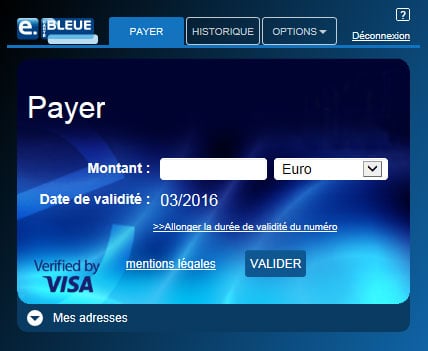What is a virtual bank card?

With the constant aim of offering new financial products and services, payment players have been thinking for some time about the principle of the virtual bank card, also known as “e-Carte Bleue”. Beyond the innovative aspect, security is always a key issue when offering a payment service, and the e-Carte Bleue has some arguments in its favor.

Source : E-carte Bleue.info
How does the virtual bank card work?
As its name suggests, the virtual bank card has no physical form. It is therefore similar to the many wallet services available today, being stored on a smartphone or a computer.
The main difference between these two services is the ephemeral nature of the virtual bank card. It joins the principle of another innovative card that is the one with dynamic cryptogram, providing temporary bank details to the holder. In other words, an e-Carte Bleue user will be able to generate these details via the dashboard of his application linked to the service.
Once the purchase is validated, these details become obsolete and the cardholder will have to generate new ones for a new purchase on another merchant site. This principle is what differentiates the e-Carte Bleue from digital bank cards, which use real bank details and can therefore pose security concerns.
Although originally designed for online purchases, the virtual bank card can very well be used for in-store purchases. As mentioned before, the possibility to store this e-card on your smartphone will finally allow you to use it as a physical card during a contactless payment. The fields of application of the virtual bank card are therefore numerous, both physical and digital.

Source : VISA
Benefits of the service
The E-carte Bleue therefore meets various needs, but it should be noted that its main argument lies in its security, as is often the case when talking about payment methods and services.
The fight against fraud is a key issue for payment service providers, who are constantly looking for ways to reduce it. Even though the fraud rate on bank cards is relatively low when compared to other payment methods, it still exists.
Fraudsters are constantly adapting to the context, and every day they learn to better circumvent the barriers put in place by the payment regulatory authorities and by its players. The digital era has forced them to adapt security to the new digital frauds, and the virtual bank card fits perfectly into this adaptation.
The information on this card can always be recovered by fraudsters. But how to take advantage of this information when it is only valid at the time of the transaction? In addition to the temporary aspect, each E-Carte Bleue number only works for one store, for a specific amount and for a specific period.
Beyond the public domain, the e-Card is seen as a useful tool for managing company expenses. The ease of generating virtual card numbers avoids a lot of administrative meanders and allows for optimal management of these expenses.
The virtual bank card therefore has a lot going for it, and like many of the new payment methods we regularly discuss in this column, it should continue to become more democratic. However, it will not be able to meet all payment needs. For example, you cannot make recurring payments with a virtual bank card. On the other hand, for all other types of traditional one-time payments, it perfectly fulfills its role of security and ease of use, now that it can also be stored on the cardholder’s smartphone.



